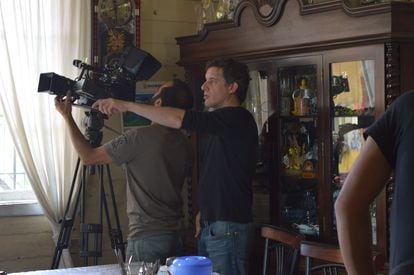In the more than two decades that Manuel Bauer (Lima, 47 years old) has spent outside Peru, he has not stopped remembering the usual excursions to the Andes that he made in his university years, with friends and a backpack on his shoulder.
This Madrid-based film and television editor had been trying since 2011 to get his first feature film off the ground.
This is the documentary
Vida ferrea
, with the
he travels in a very particular way the landscapes of his youth.
Filming it has been the way to return to his country.
This weekend, the film had its world premiere at the Swiss film festival Visions du Réel.
Taking advantage of the route of the Central Andean Railway, a freight train that transports minerals, the filmmaker raises the viewer on the back of what he calls the “steel snake”.
Together with his camera, she travels through the heart of Peru during the celebrations of Independence Day, on July 28.
The trip begins in Cerro de Pasco, located at the top of his beloved Andes, at almost 5,000 meters high, and ends in Callao, on the shore of the Pacific Ocean.
Manuel, inhabitant of Cerro de Pasco, portrayed in the documentary 'Vida férrea'.
Throughout this journey, between dangerous gorges and eternal excavations, Bauer comes across the confessions of his compatriots.
"They are people often abandoned by the State, which in recent times has privatized both the mining company and the railway company," he explains from Nyon, home of the Swiss event in which he competes in its international feature film section.
Iron Life
is a
highly observational
railroad movie .
Take advantage of the visual and sound textures of the Peruvian natural landscape to tell a story of disenchantment.
While wealth in the form of minerals leaves the country when it reaches the port, its inhabitants face the negative consequences of poorly exploited exploitation.
Their lives are marked by pollution and the lack of work and training alternatives, which make the capital, Lima, concentrate almost a third of the country's total population, recalls Bauer.
In the initial season appears Manuel, a resident of Cerro de Pasco who suffers from chronic altitude sickness and who has no one left, while he lives installed in the nostalgia of a past life, in a city that touches the clouds.
One of the train stops gives rise to a chat with Betty, a nurse who fights against the burden of living near the big mining companies.
The camera also shows the harsh conditions for the railwaymen on this dangerous route.
Manuel Bauer, in black, during the filming of the documentary 'Vida Férrea'.
“When I started this project, Peru was in full euphoria for the rebirth of this industry.
It felt first world.
But in these 12 years that initial bonanza has not been reinvested in other economic activities or in services of the State, such as education and health.
That hope has turned into disappointment and also adds to the current political instability”, says the director.
It is a story that repeats itself over and over again.
“Peru did not take advantage of the extractivist boom of guano, saltpeter, rubber and anchovy in other times.
He lives permanently in the myth of Sisyphus [hero carrying a rock to the top of the mountain to see it fall again, repeating the process for all eternity]”, he laments.
Produced by the Peruvian TV Cultura and the Spanish Kilovivo SL, it took a long time for
Vida
Férrea to find the necessary financing so that a team of eight people could travel to the area to shoot.
Bauer waited so long that the initial idea for this film completely changed with respect to what the viewer can now see on the screen.
In principle, he devised a fictional plot that could serve as a common thread for what he wanted to tell.
But finally it was the train itself, with the cadence of its rattle and whistle, that became its main narrator.
“Little by little, I realized that my idea of fiction was poorer than what the country was telling me.
Reality dragged us into the documentary genre”, he admits.
After passing through Visions du Réel, the film has confirmed its presence this May at the DocsBarcelona documentary film festival.
Before, on April 20, a tour will start in Cerro de Pasco throughout Peru, offering specific screenings in 12 of its cities.
Many of them will be the ones that appear in the footage, although he will also stop at others that, although they are shown in it, "have very similar realities," concludes the filmmaker.
Manuel Bauer's documentary 'Vida Férrea' follows the journey of Peru's Central Railroad, from the top of the Andes to the shores of the Pacific Ocean.
🇵🇪
You will find it in the #DocsBcn 2022 schedule.
Watch the trailer here ▶️ https://t.co/jaIXmUJaoE pic.twitter.com/siUbBe8cFM
– DocsBarcelona (@DocsBarcelona) April 8, 2022









/cloudfront-eu-central-1.images.arcpublishing.com/prisa/2BJPLFOPENCKDMK6PPADXUU37E.jpg)